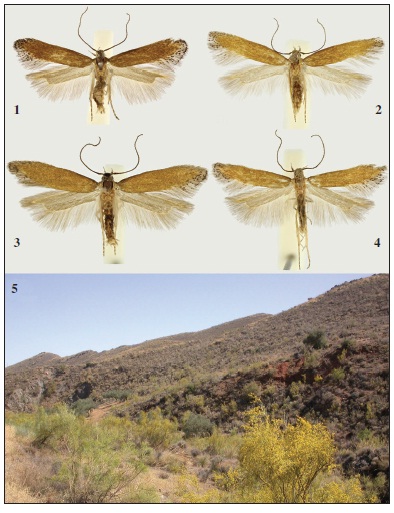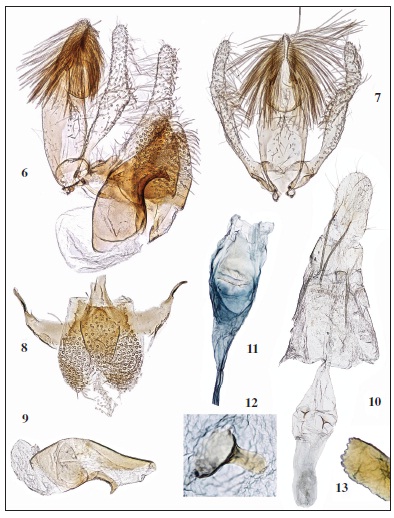

Artículos
A new Stomopteryx Heinemann, 1870 from southern Spain (Lepidoptera: Gelechiidae)
Un nuevo Stomopteryx Heinemann, 1870 del sur de España (Lepidoptera: Gelechiidae)
A new Stomopteryx Heinemann, 1870 from southern Spain (Lepidoptera: Gelechiidae)
SHILAP Revista de Lepidopterología, vol. 46, no. 182, 2018
Sociedad Hispano-Luso-Americana de Lepidopterología
Received: 14 February 2018
Accepted: 13 March 2018
Published: 30 June 2018
Abstract: The description of Stomopteryx jeppeseni Karsholt & Sumpich, sp. n. is presented. The description is based on a large series of specimens originating from Andalusia in southern Spain. The newly described species is morphologically most similar to S. lusitaniella Corley & Karsholt, 2014, but due to different coloration of the wings they are easily distinguishable. Photos of the adults and genitalia of both sexes are given.
Keywords: Lepidoptera, Gelechiidae, Stomopteryx, new species, Spain.
Resumen: Se presenta la descripción de Stomopteryx jeppeseni Karsholt & Sumpich, sp. n. La descripción está basada en una gran serie de ejemplares procedentes de Andalucía, en el sur de España. La nueva especie descrita, es morfológicamente más parecida a S. lusitaniella Corley & Karsholt, 2014, pero debido a la diferente coloración de las alas, ambas son fácilmente distinguibles. Se proporcionan fotos del adulto y de la genitalia de ambos sexos
Palabras clave: Lepidoptera, Gelechiidae, Stomopteryx, nueva especie, España.
Introduction
Gelechiidae is among the least known Lepidoptera families in Europe. Although some progress has been made (e.g. HUEMER & KARSHOLT, 2010), a number of undescribed species are known to specialists, and even though it is preferable to describe these within revisionary framework, there is an increasing need to have such species named in order to be able to discuss them for taxonomic or conservation purposes. Below we describe a new, distinct species belonging to the genus Stomopteryx Heinemann, 1870.
Stomopteryx, as currently restricted, includes 15 species from Europe (KARSHOLT, 2011; CORLEY & KARSHOLT, 2014; NEL & VARENNE, 2016), 18 species from the Afrotropical region (DE PRINS & DE PRINS, 2017) and some additional species from North Africa and Asia.
Abbreviations used
HW Collection Hugo van der Wolf, Neunen, The Netherlands
MNCN Museo Nacional de Ciencias Naturales, Madrid, Spain
NMPC National Museum, Prague, Czech Republic
ZMUC Zoological Museum, Natural History Museum of Denmark, Copenhagen, Denmark
ZT Collection Zdenko Tokár, Sal’a, Slovakia
Stomopteryx jeppeseni Karsholt & Sumpich, sp. n. (figs 1-4, 6-13)
Holotype ♂, “SPAIN: ALMERÍA | Sierra de Alhamilla | 37 00’ 02’’ N 02 09’ 58’’ W | Nijar env. 560 m | 13-14.6.2007 | Jan Sumpich leg.” “Holotypus | Stomopteryx jeppeseni | Karsholt & Sumpich, 2018” “Photo / | Gen. prep. | J. Sumpich | 18/164” (NMPC).
Paratypes (87 ♂ ♂, 22 ♀♀). SPAIN: ALMERÍA: 15 ♂♂, 6 ♀♀, same data as holotype (2 ♀♀, M.Dvorˇák leg.) (NMPC, 1 ♂, in MNCN); 1 ♂, ditto, but 30-IV-2008, J. Sumpich leg. (NMPC); 1 ♂, Sierrade Alhamilla, vicinity of Níjar, 560 m, 19-V-1999, M. Dvorˇák leg. (NMPC); 1 ♀, 5 km N Carboneras,10 m, 15-X-1992, M. Fibiger leg. (ZMUC); 2 ♂♂, 1 ♀, 5 km SW Tabernas, Rambla de Tabernas, 200m, 28-V-1998, P. Skou leg. (ZMUC); 1 ♂, ditto, but 350 m, 18-25-IV-2000, C. Hviid & B. Skule leg.(ZMUC); 1♂, ditto, but 350 m, 18-25-IV-2001, C. Hviid, P. Skou & B. Skule leg. (ZMUC); 1 ♂, 2 kmW Tabernas, Rambla de Tabernas, 400 m, 3-V-2000, P. Skou leg. (ZMUC); 3 ♂♂, ditto, but 24-25-V-2006, P. Skou leg. (ZMUC); 11 ♂♂, 2 ♀♀, ditto, but 2-3-V-2008, J. Sumpich leg. (NMPC); 1 ♀, dittobut Z. Tokár leg. (ZT); 1 ♂, ditto, but 20-21-IV-2009, Z. Tokár leg. (ZT); 1 ♂, ditto, but 7-VII-2010, Z.Tokár leg. (ZT); 1♀, Cabo de Gata, 5 m, 2-V-2000, P. Skou leg. (ZMUC); 2 ♂♂, Sierra de Alhamilla,road Turrillas-Colativi Hill, 1000 m, 15-19-VI-2007, J. Sumpich leg. (NMPC); 1 ♂, Sierra de los Filabres, Alto del Calar del Gallinero, 2000 m, 17-18-VI-2007, J. Sumpich leg. (NMPC); 1 ♂, Mojácar, 50 m, 4-V-2008, J. Sumpich leg. (NMPC); GRANADA: 2 ♂♂, Almuñecar, 150 m, 6-12-V-2000, C. Hviid& B. Skule leg. (ZMUC); 2 ♂♂, ditto, but 125 m, 11-23-V-2002, G. Jeppesen; 2 ♂♂, ditto, but 125 m,17-29-V-2003, G. Jeppesen leg.; 1 ♂, ditto, but 135 m, 26-VIII-15-IX-2005, G. Jeppesen leg.; 1 ♂, 1 ♀ ,25 km N Almuñecar, Moscaril, 500 m, 14-22-V-2002, G. Jeppesen leg.; 2 ♂♂, ditto, but 17-29-V-2003,G. Jeppesen leg.; 13 ♂♂, 1 ♀, ditto, but 28-VIII-9-IX-2004, G. Jeppesen leg.; 19 ♂♂, 5 ♀♀ ditto, but26-VIII-15-IX-2005, G. Jeppesen leg.; 1 ♂, Sierra de los Guájares, 1220 m, 26-VIII-15-IX-2005, G.Jeppesen leg.; 1 ♂, Sierra del Chaparral, 400 m, 4-V-2009, G. Jeppesen leg. (all ZMUC); 1 ♀, MÁLAGA:Camino de Benahavis, 150 m, 21-VI-1980, leg. E. Traugott-Olsen, genitalia slide 5336 Traugott-Olsen;1 ♂, ditto, but 24-VI-1981, genitalia slide 5600 Traugott-Olsen; 1 ♀, ditto, but 8-VI-1983, genitaliaslide 5719 Traugott-Olsen (all ZMUC); 1 ♀, prov. Málaga, 5 km W Archez, Casa Las Jaras, 1-VI-2008,leg, H. van der Wolf; 1 ♀, ditto, but 15-VI-2011 (HW).
Description adult (Figs 1-4): Wingspan 8-11 mm. Labial palpus slender; segment 2 blackish brown with lighter inner surface and white apex; segment 3 shorter than segment 2, whitish with black tip. Antenna ringed with black and dark grey. Head light grey-brown, thorax grey-brown, tegula as forewing. Forewing clear ochreous, without markings; some black-tipped scales along termen; cilia light grey, with black tips. Hindwing grey; cilia pale grey with yellow tinge at base.
Variation: There is some variation in the amount of black-tipped scales along the termen. Otherwise there is almost no variation.
Male genitalia (Figs 6-9): Tegumen elongate, elliptical. Uncus with long thick hairs reaching middle of tegumen. Gnathos broadly rounded. Valvae narrow, almost straight, broadened in the middle and with rounded apex. Vinculum with a pair of round hairy flaps covering the phallus. Phallus broad, slightly bent, and with small sclerotized pointed tooth.
Female genitalia (Figs 10-13): Papillae anales rounded, both pairs of apophyses comparatively short. Ductus bursae narrow, slightly broadened near antrum, as long as bursa copulatrix. Bursa copulatrix elongated with two small drop-shaped signa on hollow bases.
Diagnosis: The species is recognised by its relatively small wingspan and by the clear ochreous coloration of the forewing and lack of markings. It may resemble some forms of Stomopteryx remissella (Zeller, 1847), but that species has three black spots in the forewing which is often reddish at base. S. lusitaniella Corley & Karsholt, 2014 and the larger S. hungaricella Gozmány, 1957, which have almost unmarked forewings, but these are blackish or blackish brown – not clear ochreous as in S. jeppeseni sp. n. Genitalia of both sexes are very similar to other Stomopteryx species, especially to S. lusitaniella. Small but distinct differences are in the shape of valvae in males (almost straight with the bulge in S. jeppeseni sp. n., curved and without conspicuous bulge in S. lusitaniella), and also in the shape the gnathos (smoothly oval in S. lusitaniella, noticeably widespread in S. jeppeseni sp. n.).
Female genitalia of both species are without noticeable differences (see also CORLEY & KARSHOLT, 2014). Legs of S. jeppeseni sp. n. and S. lusitaniella have been sent for DNA barcoding, and the results will be published in a study of the DNA barcodes of European Gelechiidae (P. Huemer et al., in preparation).
Biology: Early stages and host plant are unknown. Adults have been collected from late April to middle of October, and the species may thus be bivoltine. Most localities are situated in the lowlands between sea level and 1000 m altitude, with a single specimen from an altitude of 2000 m. It is abundant predominantly at lower altitudes up to 500 m above sea level. Various kinds of dry steppes with sparse vegetation, mostly without trees, are predominant habitats (Fig. 5).
Distribution: Only known from the provinces of Almería, Granada and Málaga in southern Spain. Derivatio nominis: Named in honour of Mr. Gert Jeppesen (Denmark) who collected most of the type material.
Remarks: Although the species of Stomopteryx show considerable diversity in external appearance, differences in genitalia are small, with the result that some easily distinguishable species can scarcely be separated by genitalia. Of the European species, most species have distinctive wing markings, only S. hungaricella, S. lusitaniella and S. jeppeseni sp. n. have forewings almost without markings. In the catalogue of Lepidoptera of the Iberian Peninsula (VIVES MORENO, 2014) S. jeppeseni sp. n. should be placed (together with S. lusitaniella) between S. remissella and S. flavipalpella Jäckh, 1959.
We examined type specimens of the Stomopteryx species described from North Africa (S. bivittella (Chrétien, 1915) - TL: Tunisia; S. deverrae (Walsingham, 1905) - TL: Algeria; S. diplodoxa Meyrick, 1936 - TL: Tunisia; S. discolorella Turati, 1924 - TL: Libya; S. flavoclavella Zerny, 1936 TL: Morocco; S. geryella (Chrétien, 1915) - TL: Algeria; S. kermella Chrétien, 1915 - TL: Algeria; S. lacticolella - Turati, 1924 - TL: Libya; S. maculatella (Lucas, 1956) - TL: Morocco; S. multilineatella (Lucas, 1932) - TL: Morocco; S. nigricella (Chrétien, 1915) - TL: Algeria and Tunisia; S. quadripunctella Chrétien, 1915 - TL: Algeria; S. pelomicta Meyrick, 1928 - TL: Morocco; S. plurivittella Turati, 1930 - TL: Libya; S. speciosella Zerny, 1936 - TL: Morocco; S. tenuisignella Turati, 1924 - TL: Libya; S. zanoni Turati, 1922 - TL: Libya). Most of these are distinctly larger than S. jeppeseni sp. n., and none of them have a clear ochreous coloration of the forewing and lack of markings.
Acknowledgements
The authors would like to thank the following colleagues for the loan or donation of material and information: Marek Dvorˇák (Czech Republic), Carsten Hviid (Denmark), Gert Jeppesen (Denmark), Peder Skou (Denmark), Bjarne Skule (Denmark), and Zdeno Tokár (Slovakia). Emmanuel Arriaga-Varela (México) translated the abstract into Spanish, and Martin Corley (U.K.) kindly commented on and improved the English language of the manuscript. This work was financially supported by Ministry of Culture of the Czech Republic (DKRVO 2018/13, National Museum, 00023272) (J. Sumpich).
BIBLIOGRAPHY
CORLEY, M. & KARSHOLT, O., 2014.– Stomopteryx lusitaniella Corley & Karsholt, sp. n., pp. 232, 236, 238242.– In M. CORLEY. Five new species of Microlepidoptera from Portugal.– Entomologist’s Record and Journal of Variation, 126: 229-243.
DE PRINS, J. & DE PRINS, W., 2017.– Afromoths, online database of Afrotropical moth species (Lepidoptera). Available from https://www.afromoths.net/ (accessed 17 January 2018).
HUEMER, P. & KARSHOLT, O., 2010.– Gelechiidae II (Gelechiinae: Gnorimoschemini).– In P. HUEMER, O.KARSHOLT & L. LYNEBORG. Microlepidoptera of Europe, 6: 586 pp. Apollo Books, Stenstrup.
KARSHOLT, O., 2011.– Gelechiidae.– In O. KARSHOLT & E. J. van NIEUKERKEN (eds.). Fauna Europaea, version 2.4. Available from https://www.faunaeur.org (accessed 17 January 2018).
NEL, J. & VARENNE, T., 2016.– Entomologie prospectrice: description de la femelle de Nematopogon argentellus G. & P. Leraut, 2014 et découverte de huit espèces de microlépidoptères nouvelles pour la France ou pour la science (Lepidoptera, Adelidae, Tineidae, Bucculatricidae, Gracillariidae, Yponomeutidae, Gelechiidae, Tortricidae).– Revue de l’Association Roussillonnaise d’Entomologie, 35: 28-40.
VIVES MORENO, A., 2014.– Catálogo sistemático y sinonímico de los Lepidoptera de la Península Ibérica, de Ceuta, de Melilla y de las islas Azores, Baleares, Canarias, Madeira y Salvajes: 1184 pp. Suplemento a SHILAP Revista de lepidopterología, Improitalia, Madrid.
Figuras


Notes
Author notes
* Autor para la correspondencia / Corresponding author: jansumpich@seznam.cz